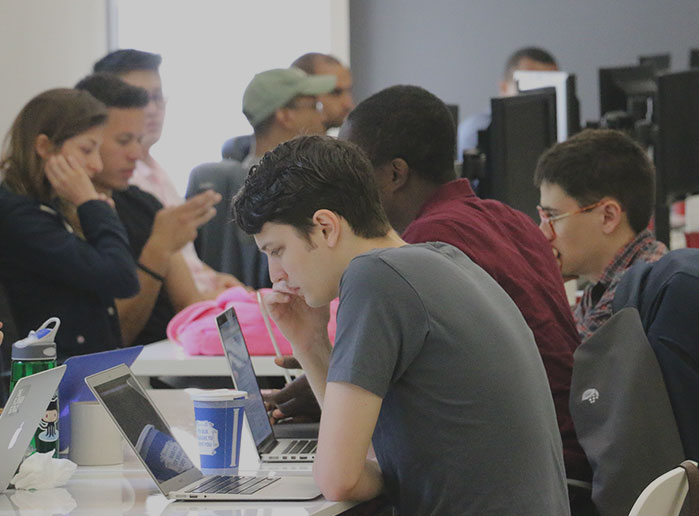So, you’re interested in a career in data science, congrats! The rise of big data has created many new job opportunities across both technology and traditional businesses. We’re excited about the potential of big data, but finding the right career can seem like a daunting task. There are analysts, scientists, engineers, gurus, AI trainers, robot whisperers, and so many more. Where do you even start? To shed light on this, we’ll break down the two most popular jobs within data science.
A job description for a data scientist and one for a data analyst may look similar, but there are key differences between the two careers. In this exciting world of machine learning, algorithms, and big data, here’s the difference between a data analyst and a data scientist.
Data science…big data, bigger impact
Big data leads to even bigger opportunities and a few challenges. More companies are dealing with a massive influx of data with no practical or scalable way of dealing with this bounty. Key insights are missed and lucrative business opportunities may disappear if companies can’t take advantage of their data. That’s why we need data analysts and data scientists. While both were borne from big data, a data analyst acts as a translator while a data scientist acts in a hybrid capacity helping to turn data into something practical through code.

Data analysts translate a company’s valuable data to identify trends, find solutions, or to project future growth. Analysts and researchers have been around long before big data, which is why data analyst roles are well-defined. Data analysts don’t need to have advanced coding skills, but have experience with analytics software, data visualization software, and data management programs.
More importantly, analysts need to be effective communicators because they are supporting teams with varying degrees of technical understanding. An analyst is a storyteller and a prophet finding truths in data. For example, you can see the work of a data analyst in the form of a marketing report projecting future sales of a product or the success of an ad campaign.
Some data analysts do use code in their day-to-day duties, based on job requirements found on Glassdoor and discussions on Quora, but it’s typically not required or requires only a basic understanding to help clean and normalize a company’s data. Learning to code or a program language can help gain a competitive edge in the field. It’s a great entry point for anyone that’s fascinated about the potential of big data. Data analysts are in high demand and jobs are found across all industries, according to available opportunities on Glassdoor.
Data analyst vs. data scientist
There a few differences between a data analyst and a data scientist. Analysts answer questions and address business needs and are more involved on business planning than a scientist, for example. However, the biggest difference between a data scientist and a data analyst is the scientist’s coding expertise. A data scientist interprets data, much like a data analyst, but can use code to build models or algorithms to gain even more insight into that data.
We can use Netflix to highlight the data analyst vs. data scientist difference. Netflix has hundreds of millions of subscribers watching a range of TV shows and movies. That’s information a data analysis can use to identify viewing habits or consumer trends. An analyst can use the data to identify the most popular shows or movies in each state, country, or by other categories that can be used to determine what gets promoted by Netflix.
Netflix always figures out the right movie or TV show to recommend. Sure, some of that is based on your own viewing habits. But, Netflix also divides users into thousands of taste groups through machine learning and algorithms, according to Wired. Netflix’s recommendation system finds common threads in everything you’ve watched to create individual profiles. Netflix is also tagging everything you watch, which adds another layer of data that’s used to create a profile group. That all adds up to a recommendation for “Action Movies Featuring Strong Female Leads” or “Gritty Cop Dramas.” Netflix’s algorithm may get the glory, but a team of data scientists, analysts, and engineers created the recommendation system.
Data scientists are rare and have experience with software engineering, coding, statistical analysis, and data visualization. Scientists know statistical computer languages, such as Python or SQL, and have built a few models. That’s a rare combination and it’s why data scientists are so coveted. It’s the hottest job in America, according to Glassdoor, and it’s only going to get hotter as more companies seek data scientists to make sense of their data.
Making the leap from analyst to scientist
Whether you’re interested in becoming a data analyst or a data scientist, both jobs are in high demand. There are over 4,500 data scientist job openings on Glassdoor with a median salary of $110,000. Data analysts are also highly prized, but the median base salary is much lower than a data scientist at $60,000.
Considering both roles have plenty of overlap, the key difference between a data analyst and a data scientist is coding expertise. For a data analyst, learning SQL and Python could lead to a potential $50,000 median base salary. Best of all, learning how to code requires weeks and not years.
If becoming a data scientist sounds intriguing, Flatiron School offers several ways to begin your career in big data. Our Immersive Data Science Bootcamp in New York will turn you into a data scientist in only 15 weeks. For those who want to sharpen their skills or may not be quite ready to change careers, our part-time Intro to Data Science course on our New York and London campuses may be the right option for you. If you’re on the fence about data science, or unsure if you can commit to a full bootcamp, our online Data Science Bootcamp Prep covers the basics with over 75 hours of curriculum.
Written byFLATIRON SCHOOL
Make yourself useful.


